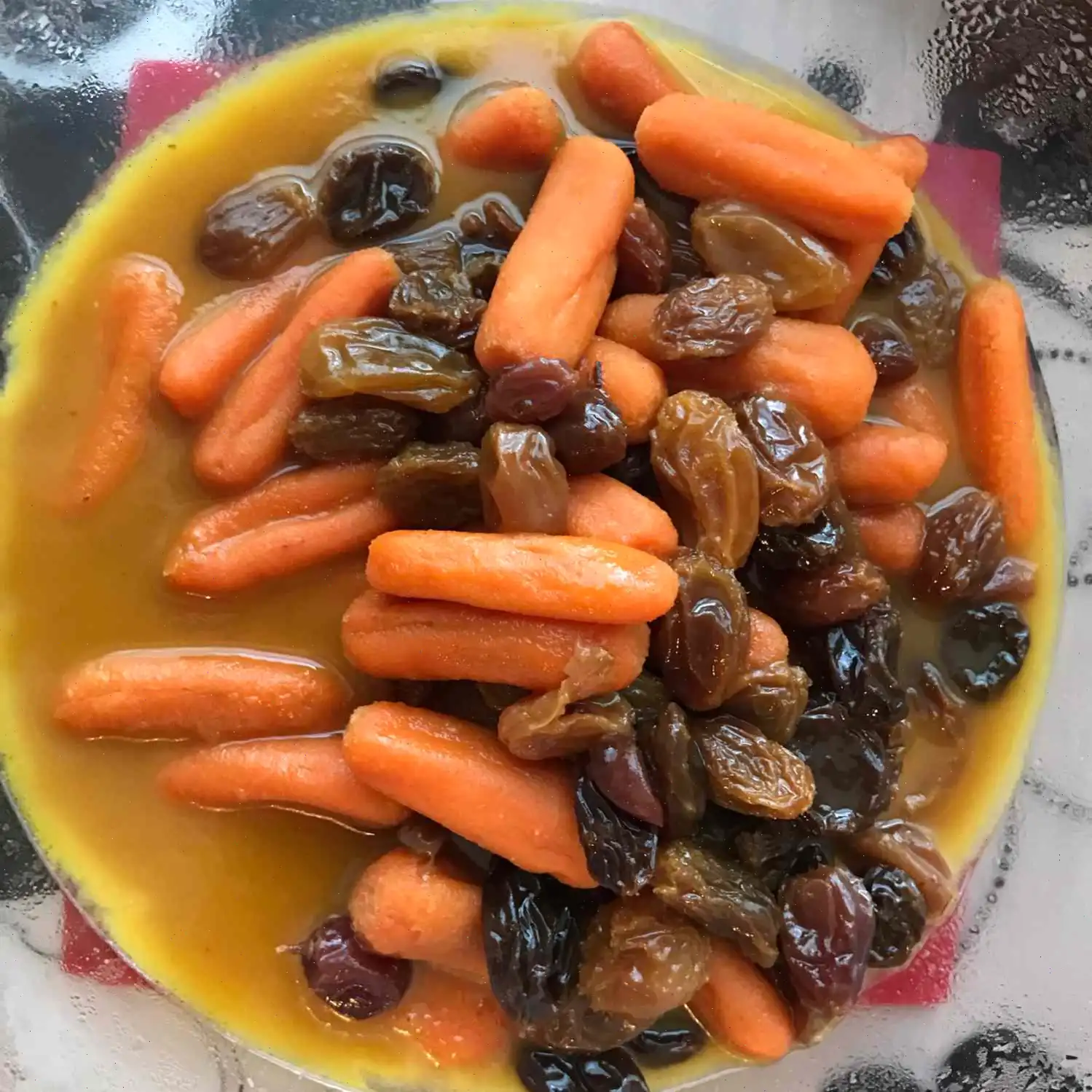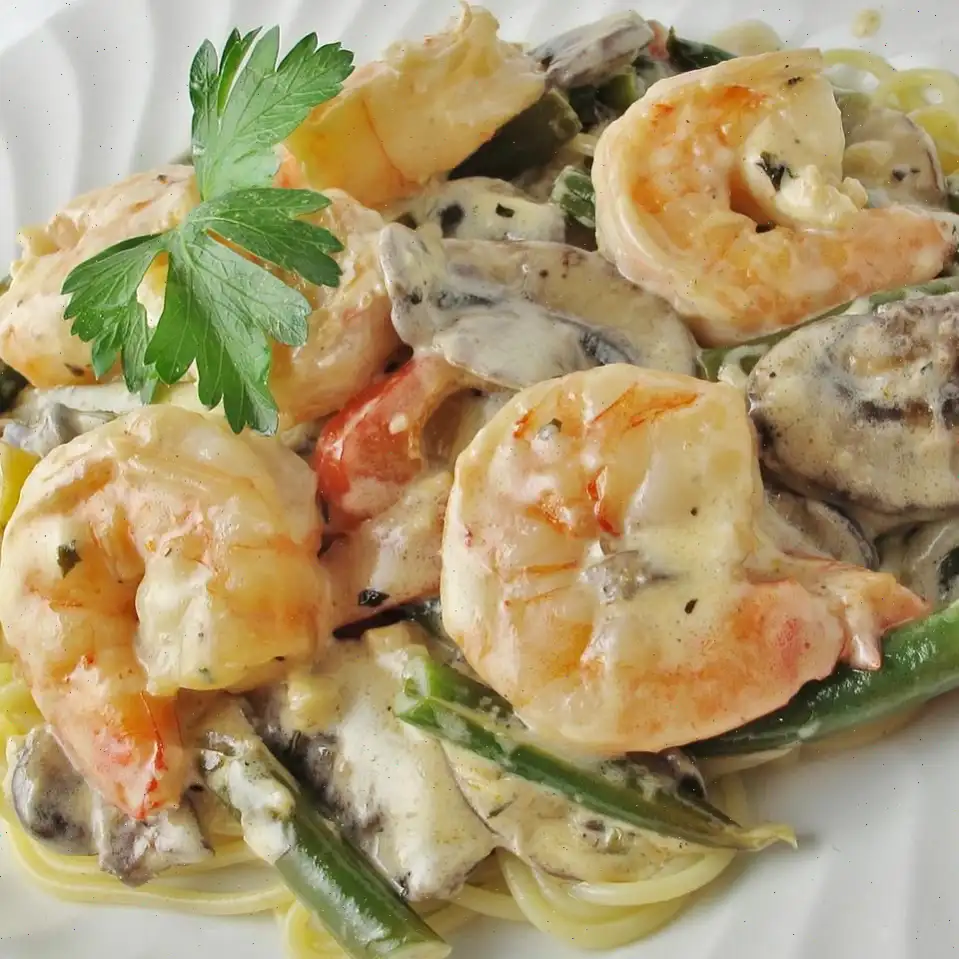
Orange Juice Tzimmes Recipe
Ingredients
- 8 large carrots
- 1 cup prunes
- 2 cups orange juice
- cup white sugar
- 4 tablespoons butter, melted
- 1 teaspoon grated lemon zest
- teaspoon grated fresh ginger root
Directions
- Place the carrots and prunes into a pot. Cover the vegetables with orange juice.
- Bring the mixture to a boil, then allow it to boil for 10 minutes.
- Stir in the sugar and melted butter. Reduce the heat to a simmer.
- Let the mixture simmer gently for about 1 hour or until the liquid is almost absorbed.
- Sprinkle the dish with grated lemon zest and fresh ginger, and simmer for another 5 minutes.
Nutrition Facts (per serving)
| Calories | 255 |
| Total Fat | 8g (11% Daily Value) |
| Saturated Fat | 5g (25% Daily Value) |
| Cholesterol | 20mg (7% Daily Value) |
| Sodium | 123mg (5% Daily Value) |
| Total Carbohydrate | 47g (17% Daily Value) |
| Dietary Fiber | 5g (18% Daily Value) |
| Total Sugars | 35g |
| Protein | 2g (5% Daily Value) |
| Vitamin C | 48mg (54% Daily Value) |
| Calcium | 58mg (4% Daily Value) |
| Iron | 1mg (7% Daily Value) |
| Potassium | 687mg (15% Daily Value) |
Note: Percent Daily Values are based on a 2,000 calorie diet. Your daily values may be higher or lower depending on your calorie needs. Nutrient information is based on available data for each ingredient. If following a medically restrictive diet, consult your doctor or dietitian before preparing this recipe.
Orange Juice Tzimmes is a sweet, stewed dish that combines carrots, prunes, and a rich blend of orange juice and lemon zest. Traditionally served during Jewish holidays such as Rosh Hashanah and Passover, this dish has become a symbol of comfort and celebration within Jewish culinary traditions. Let's take a deeper dive into its origins, regional variations, and unique qualities.
History and Origins
The word "Tzimmes" comes from the Yiddish term "tzimmes", which means "a big fuss" or "a big deal"a fitting name for a dish that requires careful preparation and results in a sweet, flavorful combination of ingredients. Tzimmes is believed to have originated in Eastern Europe, particularly among Ashkenazi Jews. Traditionally, it was made with carrots and sweet root vegetables like sweet potatoes, with a variety of dried fruits and a touch of honey or sugar to add sweetness. Over time, different variations evolved, and the addition of orange juice, as seen in this recipe, became a popular modification, enhancing the natural sweetness of the dish.
Regional Variations
Tzimmes recipes can vary greatly depending on the region and personal preferences. In Eastern Europe, Tzimmes was often cooked with meat, such as brisket, for a hearty meal, while in modern times, it is usually served as a side dish or a dessert without meat. The most common ingredients in Tzimmes include carrots, sweet potatoes, prunes, and other dried fruits like apricots or raisins. The recipe here, featuring a blend of fresh orange juice, lemon zest, and ginger, adds a citrusy twist that is particularly popular in contemporary Jewish kitchens in North America.
What Sets Tzimmes Apart?
While there are many similar stewed dishes in Jewish and general Eastern European cuisine, Tzimmes stands out because of its signature sweetness, brought about by the combination of fruits and sugar or honey. The inclusion of orange juice further elevates the dish, adding acidity and freshness to balance the sweetness. It is also worth noting that Tzimmes is typically slow-cooked, allowing the flavors to meld together, which is a key part of its appeal.
Where Is It Traditionally Served?
Tzimmes is most commonly prepared for Jewish holidays, particularly Rosh Hashanah, the Jewish New Year, where it symbolizes the wish for a sweet year ahead. It is also a staple at Passover meals, often accompanying dishes like brisket or chicken. While traditionally served during these occasions, Tzimmes can also be enjoyed year-round, especially as a comforting side dish during colder months.
Fun Facts About Tzimmes
- Did you know that Tzimmes is often referred to as the "Jewish carrot stew"? The inclusion of carrots is symbolic, as they are associated with wealth and prosperity in Jewish tradition.
- Some variations of Tzimmes are made with sweet potatoes instead of regular carrots, giving the dish a richer, denser texture.
- The sweet, stewed flavor of Tzimmes has made it popular beyond Jewish communities, with many non-Jews enjoying it as a comforting, seasonal dish.
- Some families add a dash of cinnamon, nutmeg, or even a hint of chili pepper to bring out the flavors and add a touch of warmth to the dish.
Orange Juice Tzimmes, with its tangy citrus twist, is an excellent example of how traditional recipes evolve to meet modern tastes. Whether youre preparing it for a holiday gathering or a cozy family dinner, this dish is sure to bring joy and warmth to any occasion.
FAQ about Orange Juice Tzimmes Recipe
Comments
Heather Parker
12/10/2023 12:12:26 PM
I adjusted the recipe to make 12 portions and stuck to the specified quantities with a few tweaks: I substituted 4 cups of orange juice with 3 cups of water and 1 additional cup. I included a teaspoon of cumin and cinnamon each, along with a combination of prunes and dried apricots in equal proportions. Following the simmering process, I had excess liquid remaining, so I used a spider to separate the carrots and fruit. I then increased the heat to reduce the liquid to a syrupy consistency. The dish turned out delicious, and I will certainly be making it again.
Brenda Torres
03/08/2023 11:34:48 PM
Great recipe to begin with, easily customizable to suit your preferences. I opted for raisins over prunes and it turned out fantastic. For those seeking an alternative to fresh ginger, using 1/8 tsp of ground dried ginger worked perfectly for me.








